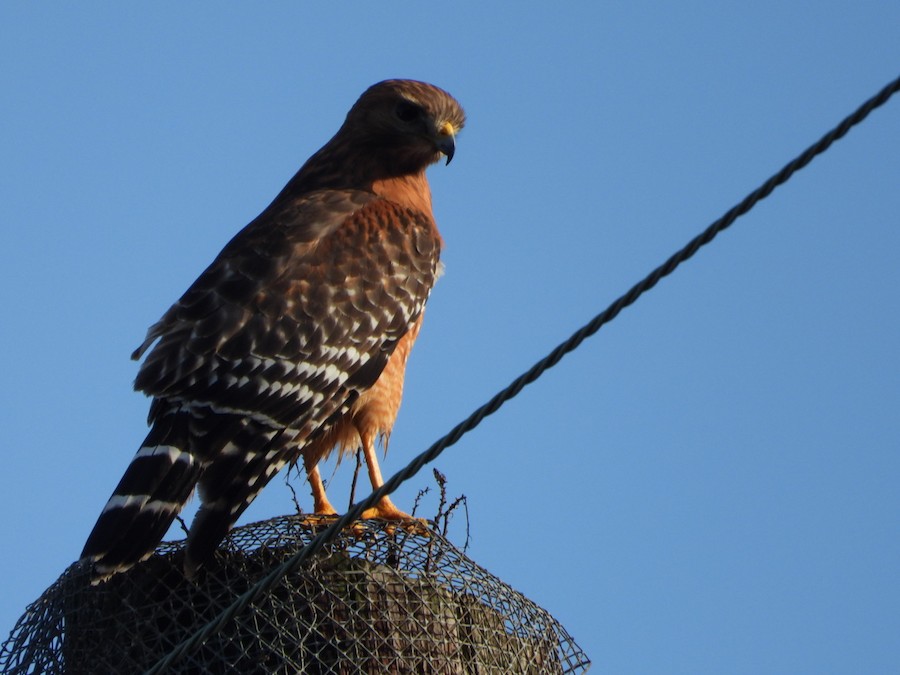by Beth Miller, PWLTMN Member

Twelve Piney Wood Lakes Texas Master Naturalists (PWLTMN), with two guest Master Naturalists from Galveston Bay Area Chapter became six teams participating in the 125th Audubon Christmas Bird Count (CBC) in Polk County on Sunday, December 15. The potential of rare bird sightings, witnessing unusual behaviors, constant challenge of playing bird hide-and-seek, and the opportunity to be a Citizen Scientist for Audubon with proven impact keeps us coming back each year.
After several years of freezing temps, flooding rains, or low overall counts, the teams enjoyed typical December weather for spotting huge kettles and committees of vultures, several rare sightings, and a noticeable drop in local water birds. One of the coolest sights was hundreds, even thousands of black vultures sunning near Lake Livingston Dam in committees, and similar numbers soaring in kettles above the dam. It’s not unusual to see small committees doing their job on the roadside, but thousands are special.
While this year’s overall bird count total was lower than 2022 and 2023, particularly for the American White Pelicans, the teams logged 74 species in 2024, including 4 unexpected species and a total of 3,722 birds. This was the highest species total in the past three CBC events, topping the 53 species of 2023 and 61 species in 2022.
It’s not just the Piney Wood region seeing drops in bird numbers and changes in arrival times, it’s happening worldwide. Extreme weather events, climate warming, and urban expansion across the globe are changing habitats and causing all migratory species to find new breeding grounds and migratory stopovers. Long-distance migrants like warblers, neotropic species, hummingbirds, geese and storks are suffering the most because their departure times and flight paths have been wired-in for millennia. Near-by migrants make small weather or food availability moves as needed and adapt.
Several of our teams spotted orange-crowned warblers, the only warbler more visible in the west than in the east. They generally breed in upper altitudes from northern California to temperate rainforest of Alaska, yet, here they were during the CBC. Their numbers have been in major decline for decades. Perhaps their arrival in Piney Woods could be in response to the rapid development on the west coast.
Spring has been coming one and two weeks earlier in some regions, stimulating plant growth cycles and insect reproduction. Many long-distance migrants arrive to find their food sources gone already. Some short distance migrants, like European Starlings, adapt; longer distance migrants, including warblers, hummingbirds, and Scarlet Tanagers don’t have body sensors to tell them it’s time to leave earlier. By missing spring, they miss the first juicy caterpillars and the tenderest leaves. 1 Learn More on migratory change.
Tracking the species and numbers of birds in our region within the same window of time every year provides a global view of how year-round and migratory birds survive within their home ranges. The reports shine lights on endangered species like the Orange-crowned Warbler and thriving kettles of vultures.
The Piney Wood region sits low in the migratory path of the Central Flyway of North America. Lake Livingston is a popular winter habitat for American White Pelicans, American Coots, and the ever popular (or not) cormorants. The lake is a year-round home to wading birds like Great Blue Herons, Great and Snowy Egrets, ibises, a variety of ducks, and gulls and terns. Of course, summer brings the hummingbirds.
The 15-mile-wide circle of the Piney Wood Region contains several distinct ecosystems. In a single day, birders can check out dense forest, riparian zones, wetlands, broad meadows and pastureland.
Perennial favorites including Carolina Wrens, Carolina Chickadees, woodpeckers and sapsuckers, Northern Cardinals, and squawking Blue Jays were spotted by most of the PWLTMN bird counters. The CBC counters included PWLTMN members Tina Crichfield, Dee Arnold, Carolyn Bischoff, Ann Turney, Karen-Elaine and Harris Murphy, Kim Chatman and wife Lynn, Shaila Palamand, Beth Miller, James Frost and wife Susie Adams, and Galveston TMN members Jason and Carolyn Miles.
The Piney Wood Region CBC reaches across Polk and San Jacinto Counties, centered on I69/US59 between Livingston and Goodrich. It covers the southeast corner of Lake Livingston, extending into southeastern San Jacinto County and encompasses much of eastern Polk County.
We won’t have the full results for the 2024-25 CBC for a few months. Look for a full report in the March or April issue of The Pine Warbler. In the meantime, visit Audubon CBC for more information and think about joining the team next December 14-Jan 5. Contact Beth Miller to get on our list. Birding experience is useful but not required!









History of the Audubon CBC
The CBC began on Christmas day in 1900 by 27 people in 25 locations across the North American continent. Audubon CBC data are used to measure how birds are responding to climate and habitat change. With two-thirds of North American bird species at increasing risk of extinction by the end of this century, Audubon’s CBC data is more important than ever for effective conservation.
The Audubon CBC is a community science project organized by the National Audubon Society. There is no fee to participate. The Audubon CBC is open to birders at all skill levels and Audubon’s free Bird Guide app makes it even easier to learn more.
Resources
1 Audubon Magazine, Spring 2022: A Matter of Timing: Can Birds Keep Up With Earlier and Earlier Springs?; By Scott Weidensaul Link
More about Audubon CBC
More About Citizen Science


